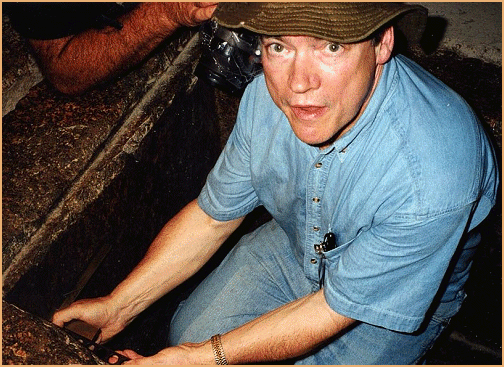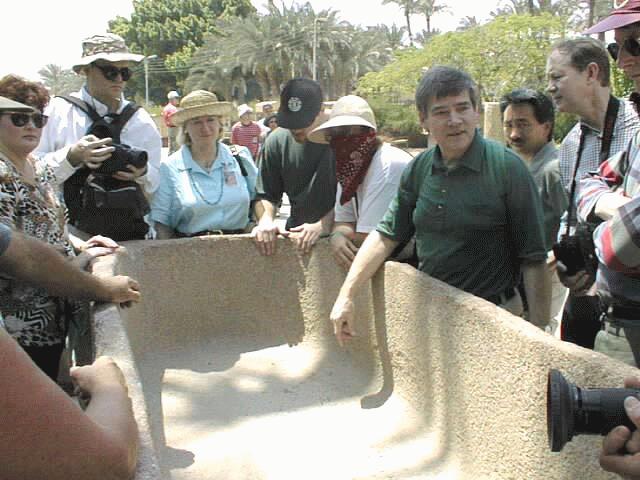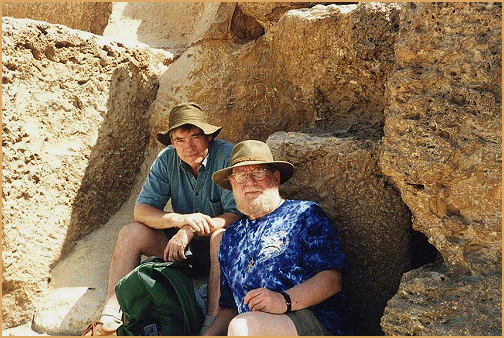THE GIZA POWER PLANT: TECHNOLOGIES OF ANCIENT EGYPT was published in August 1998. Since then I have been overwhelmed by the response to the power plant theory. The reviews have been nothing short of incredible! I have received letters and emails from all over the world that support the argument that high levels of technology existed in prehistory on this planet and that the Great Pyramid represents the pinnacle of that technology.
Though the power plant theory may explain every characteristic and noted phenomena found within the Great Pyramid, without actually replicating its function (way beyond my own personal resources) it could be ignored or dismissed as being too fantastic by those who feel more secure with conventional views of prehistory. Not so with the hard evidence of machining! There is a section in the book that is increasingly being seen as the "smoking gun" which proves, beyond a shadow of a doubt, that the pyramid builders used advanced technology. It is not a simple matter to dismiss the physical constraints imposed on those who would attempt to accurately replicate the granite artifacts found in abundance all over this ancient land. Those who try to dismiss it do so from inexperience and do not understand the subtleties of the work, or they cling desperately to the belief that Western Civilization is the first civilization to develop science and translate that science into products that require advanced methods of manufacturing.
My article, Advanced Machining in Ancient Egypt has been under public scrutiny for around 15 years. (A shortened version appeared in Atlantis Rising #9 as An Engineer in Egypt, and a complete expanded version with the latest updates fills two chapters in the book.) With the level of support that it has received from those who, in modern times, would be charged with performing the same kind of work performed by the ancient Egyptians, along with additional proof, it is rising from the rank of theory to fact. Since its original publication in Analog magazine in 1984, this tentative, controversial thorn in the side of Egyptologists has been reinforced time and time again by my own on-site inspections and others who have had the opportunity to see these incredible artifacts for themselves. The weight of evidence and the educated opinions of those who understand this kind of work, are creating a consensus that is overturning our understanding of prehistory, with implications that are stunning.
The most awesome implication has to be that civilizations are mortal!
The purpose for this article is not to belabor the obvious or to restate what others have stated more eloquently, but to bring you an update on what has happened since the book was published. There has been a lot of activity and some startling discoveries, and I have looked forward to and appreciate this opportunity to tell you about them.
On my trip to Egypt in May 1999, as a participant in the conference "Egypt in the New Millenium," I was able to perform additional on-sight inspection of some of the artifacts I described in my articles and book. I was also blessed to discover startling evidence that supports and confirms a unique and important aspect of the Giza Power Plant theory! Evidence that made chills run down my spine, for it came about in a rather unexpected, though fortuitous, manner. This evidence was inside the Great Pyramid in the Grand Gallery, and I am still amazed by what I found. But more on that later.
It is with great appreciation to the organizers, attendees and speakers of this conference that this article is written. Their spirit, diversity and camaraderie buoyed my spirit and gave me strength. But more than that, through their support and patronage of the conference (which was sometimes accompanied with frustrating and arduous conditions, with our blessed guide Hakim almost being thrown in jail), further evidence to support the power plant theory has now been captured on video and becomes part of the historical record.
A large part of my presentation at Gouda Fayed's conference center in Nazlet El Samman was to be on-sight inspection and demonstration of the precision of several artifacts. Gouda's place overlooked the Sphinx with the Giza Plateau and the pyramid complex forming an awe-inspiring backdrop. It was agreed by all that this was the perfect place to hold a conference. The real celebrities of the conference, though, were not standing in front of a microphone with laser pointer and slide remote in hand, but could be seen through the window a short distance away. The massive pyramids provided a stunning punctuation mark to each word that was spoken.
Though I can say with great confidence that I have proven that the ancient pyramid builders used advanced methods for machining granite, the full scope of the work has not yet been determined or documented. While I was in Egypt in 1995, I had taken some instruments with me to inspect the flatness of artifacts that, just by looking at them, had the appearance of being extremely precise. Just looking at an artifact, however, is not good enough when attempting to determine its true characteristics. I needed some kind of known reference with which I could compare the precision. I also needed something simple and transportable. The precision ground straight edge I used in 1995 allowed me to determine a higher order of precision in many different artifacts than what has been described in any previous literature written on the subject.
This year for the conference, in my backpack I carried with me a precision-ground 12-inch long parallel, or straight edge. The hardened steel edge was precise to within .0001 inch. I also had a precision toolmaker's solid square. I knew exactly the artifacts I wanted to use it on-the inside corners of the granite boxes at the temple of the Serapeum at Saqqara and inside the pyramids. Also in my toolkit was a set of precision Starrett radius gauges for inspecting the machined radius that makes the transition from one surface or contour of an artifact to another. These instruments are critical to our understanding of the basic attributes displayed by these artifacts from antiquity.
I was unable to access the rock tunnel at the temple of the Serapeum, where over 20 huge black granite and basalt boxes weighing over 70 tons reside. We pleaded with the officials at the site, and I even discussed it with a local businessman in the Movenpick hotel. Whether or not he had the power and influence he claimed to have, I was told that the Serapeum was closed because it was a danger to the public. I asked what kind of danger it held, and was told that there was water dripping down and threatening to collapse the roof. I didn't press the question I had in my mind about where the water came from in an arid country. There was enough other work to do, so I let it go.
Following my morning presentation on the advanced machining methods of the ancient Egyptians, the entire conference group and the film crew made their way to the Giza Plateau and into the bedrock chamber of the second largest pyramid on the plateau, Khafre's pyramid. It was in this chamber in 1995 that I had discovered the perfect flatness on the inside surfaces of the black granite box (commonly and mistakenly, in my opinion, known as the 'sarcophagus'). In 1995 I had exclaimed "space age precision" to a group of Spanish tourists who were looking on as I shone my flashlight behind the precise edge of a steel parallel and discovered the stunning precision of the black surface. Deviation in the flatness of the surface would have been revealed by this test, and I could detect none.
Though I confidently wrote articles that hailed this discovery as additional proof of the level of technology practiced by the pyramid builders, in the back of my mind was always the nagging need to go back to Egypt with additional instruments and do more tests. Each time I go to Egypt I approach these relics of the past with eager anticipation that is mixed with trepidation. Will I find them the same as the time I was here last? Will the next range of instruments I have brought with me confirm or deny what I gleaned from my previous visit?
The cool confines of the passageway leading to the bedrock chamber of Khafre's pyramid were a welcome relief from the burning Egyptian sun. My backpack was weighing heavy on my shoulders as I joined the group and made my descent. It felt familiar and right to be there at this time. I was excited to share the discovery I had made four years earlier with the wonderful people who attended the conference, as well as being able to document the event on film. But still, there was that tinge of doubt in the back of my mind. Had I made a mistake in the past? Will the new instruments reveal anything significant?
The answer, I found, was NO and YES!
Climbing into the black granite box that is set into the floor of the chamber, I placed my 12-inch straight edge on the inside surface of the box. The edge had been prepared differently than the other straight edge I used in 1995, as it had a chamfer on both corners. To all who were interested, I slid this edge along the smooth interior of the granite box with my flashlight shining behind it and demonstrated its exact precision. But while I was doing it, in the back of my mind I was anxious to perform other tests. The squareness of the corners was of critical importance to me. Modern machine axes are aligned orthogonally, or exactly perpendicular, to each other to assure accuracy. This state assures us that the corners cut into an object on the machine are square and true.
The requirements for producing this condition go beyond coincidental simplicity. I wasn't expecting the corners of the sarcophagus to be perfectly square, for perfection is extremely difficult to achieve. However, I was not prepared for the degree of perfection I found. I was flabbergasted as I slid my precision square along the top of the parallel (I used the top of the parallel to raise the square above the corner radius) and it fit perfectly on the adjacent surface. "Bloody Hell!" I exclaimed as the significance of this find came over me. I pointed it out to others in the group (Alan Alford spent the next few days mimicking me with a good natured "bloody hell"). The film crew was busy capturing it on video as I went to each corner and found the same condition. On three corners the square sat flush against both surfaces. One corner had a gap that was detected by the light test, though it was probably only about .001 inch.

"Bloody Hell!" Chris inside the granite sarchophagus located in the
Kings Chamber of the Great Pyramid
(Photograph courtesy of Stephen Mehler- conference speaker)
So not only do we have an artifact with perfectly flat surfaces, the inside corners are also perfectly square. What else is significant about this so-called sarcophagus? The corners themselves! After conducting the test with the parallel and the square, I pulled out my radius gauges to check the corner radius. As I checked the corner, I chuckled to myself with memories of a documentary I had seen in March.
Those of you who saw the Fox Special early this year will remember the world's foremost Egyptologist and director of the Giza Plateau, Zahi Hawass, pick up a dolerite ball in the bedrock chamber under one of the satellite pyramids next to Khephren's pyramid. He was describing to the Fox anchor, Suzie Koppel, the Egyptologist's theory of the methods the ancient Egyptians used to create granite artifacts. This method involves bashing the granite with a round ball until the desired shape is achieved.
I'm not disputing that this is a viable means of creating a box, and, indeed, there is evidence at Memphis near Saqqara that some boxes were created in this manner.

Chris points out that this crude sarchophagus at Memphis could have possibly
been created using 'stone balls' as some Egyptologists postulate.
(Photograph courtesy of Tim Hunkler - conference attendee)
Likewise, creating the corner radius of the box inside Khafre's pyramid using such primitive methods would be impossible. Checking this corner radius with my radius gauges, I started with a half-inch radius gauge and had to keep working my way down in size until selecting the correct one. The inside corner radius of the box inside Khafre's pyramid checked 3/32 inch. The radius at the bottom, where the floor of the box met the wall, checked 7/16 inch. It should go without saying that you cannot fit an 8-inch ball into a corner with a 3/32 radius, or even a 1-inch radius.
It is an incredible piece of work. One that speaks of high technology in its creation as well as its use. Even if we put aside the question of how it was manufactured, it still begs the question, "for what primitive purpose would we find it necessary to hold such precision and accuracy?" If we understand what it takes to perform such work, and recognize our conditioned preconceived ideas about history and prehistory, we are left with no alternative but to accept that highly advanced civilizations did exist in prehistory.
Artifacts such as these fly in the face of any previous explanations of the ancient Egyptians stone cutting methods. Egyptologists are now abandoning their previous assertions that these marvelous granite artifacts were cut using copper chisels, and I applauded them for such honesty. Moreover, there have been recent plausible demonstrations of how the ancient Egyptians cut granite using primitive methods by Denys Stocks and Mark Lehner http://www.pbs.org/wgbh/nova/lostempires/obelisk/cutting.html ). However, what has been demonstrated does not come close to explaining the remarkable precision, geometry and tool marks cut into the stones found on the Giza Plateau and other sites in Egypt.
The Giza Power Plant: More Evidence
I don't think I have ever been as surprised as I was while filming inside the Grand Gallery. (Not even when my teenage son gave me a hug.) It was especially rewarding as I had my doubts whether I would get to go into the Great Pyramid as it was closed to visitors, ostensibly for restoration, and we had spent almost a week of uncertainty as to whether access to the Great Pyramid would be granted. After numerous calls and visits to government officials, the organizers of the conference finally got the go-ahead.
While the group entered a meditative state in the King's Chamber, the film crew and I went out into the Grand Gallery to do some filming. I was going to describe, on film, my theory about the function of the Grand Gallery. This involved pointing out the slots in the gallery side ramps, the corbeled walls and the ratchet style ceiling. I was equipped with the microphone, and stood in position just below the Great Step while the camera was position on top of it. As the sound guy, adjusted his equipment, I scanned the wall with my flashlight. I noticed that the first corbeled ledge had some scorch marks underneath it, and that some of the stone was broken away. Then the camera lights came on and things became really interesting.
In all the literature I had read, the Grand Gallery is described as being constructed of limestone. But here I was looking at granite! I noted a transition point further down the gallery where it changed from limestone to granite. I scanned the ceiling and saw, instead of the rough crumbling limestone one sees when first entering the gallery, what appeared to be, from 28 feet below, smooth highly polished granite. This was highly significant to me. It made sense that the material closer to the power center would be constructed of a material that was more resistant to heat.
I then paid closer attention to the scorch marks on the walls. There was heavy heat damage underneath each of the corbeled layer for a distance of about 12 inches, and it seemed as though the damage was concentrated in the center of the burn marks. I then visually took a straight line through the center of each scorch mark and projected it down towards the gallery ramp. That was when the chills ran down my spine and the hair stood out on my neck. The line extended down in alignment with the slot in the ramp!

Chris Dunn and Stephen Mehler just after they had exited the Great Pyramid.
(Photograph courtesy of Tim Hunkler - conference attendee)
In THE GIZA POWER PLANT, I had theorized that harmonic resonators were housed in these slots and were oriented vertically toward the ceiling. I had also theorized that there was a hydrogen explosion inside the King's Chamber that shut down the power plant's operation. This explosion explained many other unusual effects that have been noted inside the Great Pyramid in the past, and I had surmised that the explosion had also destroyed the resonators inside the Grand Gallery in a terrible fire.
Only with the powerful lights of the video camera did the evidence become clear, and illuminated before me, like at no other time before, was the charred evidence to support my theory. Evidence that I was not even looking for!
Even as I finish up this article, I am receiving additional confirmation that I'm on the right track. Others are stepping forward with their own research that goes along the same lines. A complete update on this, though, will have to wait for another time. Perhaps when the Egyptian government discloses what they find behind Gantenbrink's "door" in March 2000? I am most anxious to know what is discovered behind this so-called "door." If my own prediction is correct, then yet another aspect of the power plant theory will be confirmed.
It has been an interesting year, to say the least.
© Copyright 1999 Christopher Dunn
This article is also available in Atlantis Rising Number 21 and is also avialable at the Atlantis Rising website.
